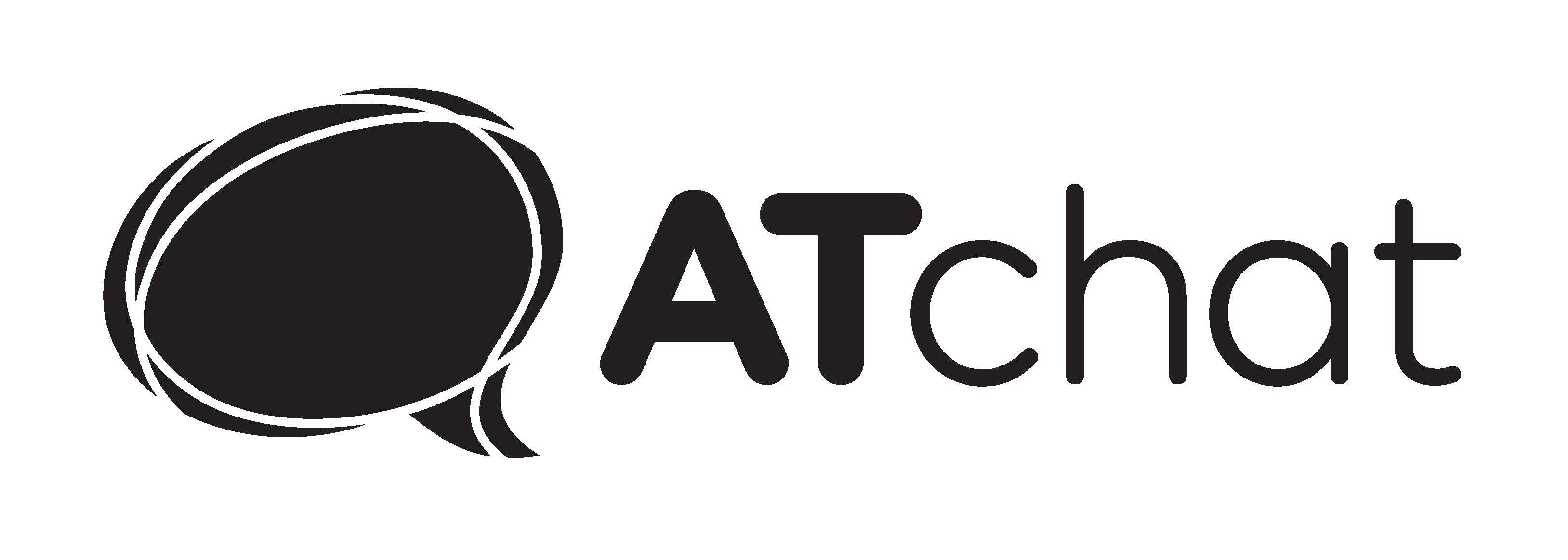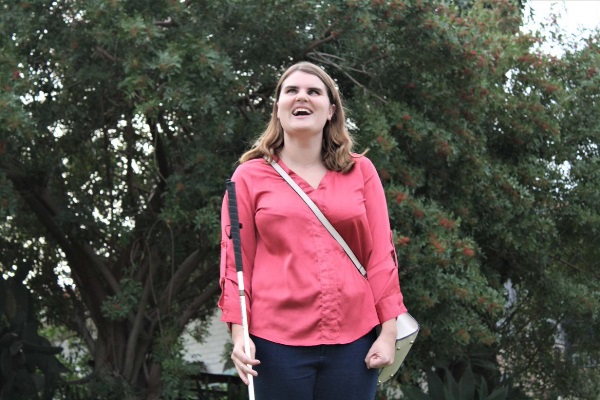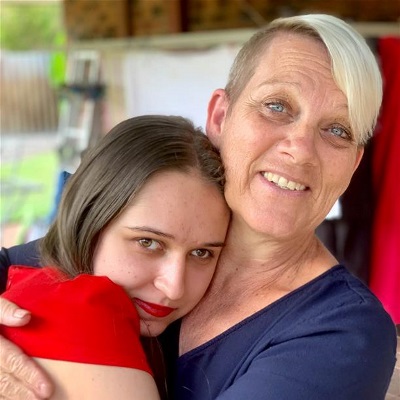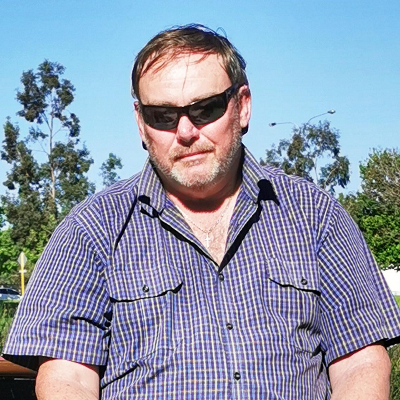AT for storytelling - Q&A with Jacqui O'Leary
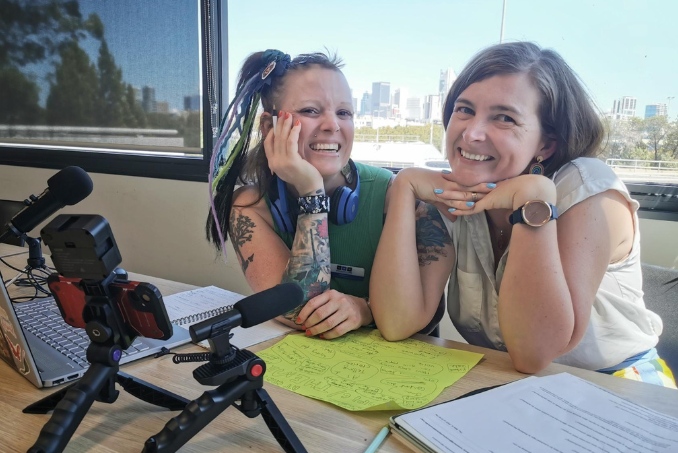
AT Chat recently had the privilege to collaborate with storyteller, podcaster, advocate and incredible mum, Jacqui O'Leary from Community Matters Media, on a podcast interview with audio description consultant Sarah Empey.
Following the series, we thought we'd sit down with Jacqui and ask her some questions about her own experiences with expressing herself, telling stories and the AT she uses to get work done.

How/why did you start your podcast?
Initially when I started the Podcast, it was born out of the idea of giving back. I've always been a storyteller as long as I can remember, and I've always believed in standing up for other people and giving them a voice.
From an early age, I realised that I had a thirst for knowledge, a heart driven by empathy, and the courage to stand up and make a difference in the world and the community.
While working with team AT Chat previously, we focused on a bundle of storytelling resources that were all about discovering how people ‘lived’, ‘played’ and ‘worked’ - and how they use their AT to build their independence and capacity.
In addition to the longer-form articles, we recorded the audio versions of the articles to deliver an experience that was rich in authenticity, but also had the tones of emotion, and inflections in voice. This was my first experience with the world of Podcasting.
One experience that resonated deeply with me was during interviews with one of our AT Chatters, Emma Vardy, and hearing her talk so impassionedly about her love for real people, real voices, and audio storytelling.
This is how Community Creatives came to pass, and I am delighted to be sharing with you all, Season 4!
.jpg?sfvrsn=a2abafef_1&MaxWidth=500&MaxHeight=500&ScaleUp=false&Quality=High&Method=ResizeFitToAreaArguments&Signature=587574A29D75259B65C27823F2D05235FD9BF4CE)
What is your process from an initial idea for a podcast topic to finalising the podcast?
I am lucky to have many ideas but harnessing this focus and fully developing an idea - end-to-end is far more challenging for me, and I have built on strategies to streamline my processes in a more manageable way now.
I found that Season 1 was more experimental, and I didn’t have as much of a plan, but Season 2 was a lot more structured in wanting to give back around my professional expertise and build capacity for people who need support around marketing and communication strategies.
If I’m unpacking a larger idea, I often use sketch note-taking and use my giant sticky note pad or whiteboard to map out my ideas in a visual way. This is useful to solidify the idea to grow and nurture it.

How do you find your audience?
As a marketing professional, I find that this is more intuitive for someone like me, however, if I was instructing a client about this, it would be very much about finding topics that people are talking about.
- I often say that you are a member of your target audience. If you respond to something and engage with a post on social media, or in a feed somewhere, chances are this has resonated with you for a reason.
- Sit with this, and ask yourself why. What clicked for you? What was the point of difference for you? What emotions were you feeling after being exposed to the content and engaging with it?
- The most successful content is generated through authentic stories that leave a lasting impact. I remember these stories, not necessarily the brand, or the business. The stories that make me feel emotion, and make me want to be a part of their message and identity.
- Your audience can be easier to find if you slow down and get to know your people, and deliver your content because you believe in it, not because you need to turn a profit.
- The right reasons come from humble actions that speak louder than words, and above all, I value the integrity that is associated with those actions.
.jpg?sfvrsn=3633dfe6_1&MaxWidth=500&MaxHeight=500&ScaleUp=false&Quality=High&Method=ResizeFitToAreaArguments&Signature=2136B18D4927FBC2C817DF8C99B89F2BCBA95BEF)
How do you organise your time and keep track of tasks?
This for me is a constant work in progress. I say that with honesty, integrity and kindness. My capacity often fluctuates, like many others living with differing needs, and due to an inability to maintain a consistent level of concentration, this is constantly a great challenge for me; and I want to be very real about that.
- I love systems. I am incredibly innovative in my ideas and my ways of tackling tasks that are challenging. I'm constantly looking for new and fresh ways of doing ‘same’ tasks in a more productive way.
- I am always open to new recommendations and ways of doing things. Through the lack of successes I have learned what works for me and what doesn't, which is still evolving to this day.
- I look for ways to automate areas in my life that give me too much to think about and take more energy than I'm willing to give.
- ‘To-do lists’ that are visual, illustrative, analogue and digital, are my guiding light.
- I also find that body-doubling is essential at times for accountability and delivering deadlines. Motivating myself on somebody else's timeline lights that fire for me to deliver for someone else, not just myself.

How might sharing stories from those with communication differences and access needs be activated?
This is a great question and I am delighted to say that I have had many different experiences over my career in inclusion and understanding of a variety of abilities and communication styles. I am always looking for ways to do things better and I constantly look for opportunities to learn from experiences and participate more in a co-design approach.
- I do not want to offer the same exact content that people would receive through a podcast if this was to be recorded: I would wish to deliver a ‘point of difference’ and an opportunity to engage and involve an audience that does not have capacity for audio content.
- I always look to include an audio transcript which goes hand-in-hand with the final production of the Podcast.
- I also share my podcast with a sound bite snapshot that enables captions that I share on the LinkedIn platform as a teaser or a summary of the Podcast episode.
- Lastly, one of the components that became rather challenging was limiting the podcast episodes in length to mostly under seven minutes. This allowed for manageable content for those who struggle with sustained focus levels and fluctuating attention spans, and engaged an audience in a concise way that would not cause mental fatigue or brain fog.
This became crucial in all my seasons for accessible and meaningful content, except for Season 4, which is longer-form due to the nature of the interviews and the conversations that take place between multiple people.

What do you think is the place for children's perspectives?
I love this question! Actually I've been working with my son quite a lot in exploring different kinds of content and digital forms of creativity, including: graphic design, storytelling, digitising illustrations, songwriting and audio content.
Currently through season 4, I am focusing on storytelling through different mediums, and I am excited to tell you that my son has expressed interest in being an interview participant and a guest on one of my episodes for this season.
I don't want to give away too much yet, but it's going to be a great listen, and I can't wait to share it with you!
He is 11-years-old, and has been a supporter of the show, and is also keen to produce his own audio content. This has been wonderful in inspiring a new generation of storytellers amongst his peers.

Do stories have to be text based or can they comprise other formats such as visuals or even performance?
Stories are aligned with creative voice, and creative voice can be anything you want it to be. I believe in delivering the stories that you can connect with, and the audience has asked for and responded to. This can take any form or unique creative expression.
This could be filmmaking, poetry readings, books, documentaries, photography, audiobooks and podcasts, songwriting, performance art and much more.
Storytelling can be as vast as you want it to be. You only need to find your voice.

Would lessons be available to learn what equipment you need and how to start out as your own podcaster?
Yes, absolutely! I always seek out great opportunities for people who want to learn new skills and develop their knowledge wherever they can! I am a great believer in skill sharing, and certainly wouldn't have acquired the knowledge I have today without amazing, kind people who are skillful and generous with their time and happy to give it.
The RTR FM Breaking Sound Barriers course is a similar opportunity to be able to provide attendees with an introduction to all things storytelling, access and Podcasting.

Why is it important to you to tell stories?
Storytelling gives people a voice. Writing and expressing myself has been a lifelong courageous and cathartic delivery of content, and all things creative.
Finding your voice is essential for wellness, and empowering someone to share their story, whilst honouring their vulnerabilities and fragilities, and supporting them in finding their courage gives my life a great sense of meaning.
.jpg?sfvrsn=f1cb79fe_1&MaxWidth=500&MaxHeight=500&ScaleUp=false&Quality=High&Method=ResizeFitToAreaArguments&Signature=DD1982ADAA0CD7FFEED8951624E536D2DCFD2313)
What AT do you need to get into podcasting?
I find that AT is so diverse in terms of how you use it, and how it builds your capacity. I don't think that is a clear answer for this question because what works for me, is most likely different than what works for you.
These are relatively generic AT, in terms of what you may use, but are essential items to support you on your journey.
- Microphone that plugs into your computer.
- A tripod for your camera or phone.
- An LED video light.
- Comfortable seat or working space.
- Ergonomic computer set-up.
- Keyboard and mouse system that works for you.
- Set of headphones that has the capacity to block out unnecessary sounds and to hear your audio more clearly.
- A recording and editing program.
- Word processing program where you can keep track of your storyboards and scripts.
- Transcribing software for transcripts and accessibility, and
- A podcasting platform to host your work.
Additional AT that I like to use includes:
- Fidgets that are noiseless, to use while recording.
- Time-timers or visual drip timers to monitor recording times and stay on track.
- Multiple large screens to access all tabs and programs I’m using so I can see where I’m up to.
- Various regulation tools.
- Visual planning aids (I like to participate in sketch note-taking).
- Basic graphic design software (Canva is great for templates that are ready-made to share on social media), and
- ‘Talk to text’ software for planning and/or consolidation.
AT apps to organise time and keep track of tasks:
- The Forest app allows you to set up different actions and times to focus, and enables you to build a tree, for every grouping of tasks completed without breaking your focus. A great little dopamine hit there too.
- The Notion app, to enable a more cohesive way to track ‘to-do lists’.
- The Pomodora method helps with concentration and forcing breaks in order to regain focus and transition between tasks.
Please note that the links provided above are not an affiliate links; we do not receive any commission if you purchase through them.
Our Facebook group Chatterbox is open to all assistive technology (AT) users. If you would like to join the AT chat to share your experience and connect with your peers about an AT solution please follow the link below and join this amazing community.
